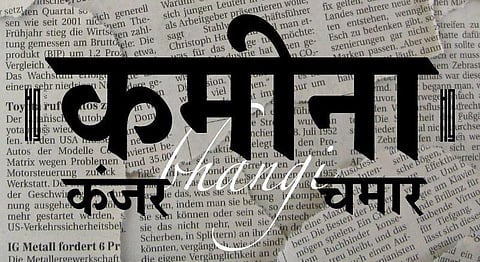
- HOMEGROWN WORLD
- #HGCREATORS
- #HGEXPLORE
- #HGVOICES
- #HGSHOP
- CAREERS
- ABOUT US
- CONTACT US

What do you think of when you hear the word ‘radical’? Does your mind conjure up men hurling molotov cocktails or guerillas engaging in armed warfare against men in uniform? Well, if that’s the case, it's not entirely your fault. Socio-politically the word ‘radical’ has been used synonymously with extremism around the world. However the etymology of the word ‘radical’ means ‘roots’. It is important, especially in linguistics, to go to the roots of a word, to contextualize or de-contextualize it. This has always been my practice as an English language teacher and last Saturday was no different.
I overheard one of my students call the other ‘chamar’. Now, if I had chided him for this behavior, I would’ve only temporarily solved the problem. Instead, I decided to handle the situation in a manner completely opposite to how Indian schools do. Without singling out either the student who used the word, I requested the entire class to pay attention. I asked them if anyone knew what the word chamar means. Not to my surprise, no one could answer. I proceeded to say, “You see no one knows the meaning but I heard one of you use it. Maybe others have used it previously as well and it's not your fault. You have heard it being used before and have invariably picked it up and that’s okay. It's exactly how language works. But knowing the meaning of a word before using it is of vital importance — that is also part of learning a language. The word ‘chamar’ comes from the Sanskrit word charmakara (“skin worker”), which is a widespread caste in northern India whose hereditary occupation is tanning leather. However, it has been used as a casteist slur and reinforces casteism and inequality. In this classroom, everyone is equal, right? Even though we may come from different castes, religions, or creeds. So would you want you to feel your friend less equal?”
My students responded with a resounding “no” and I could sense that the intended message had been well-received.
The reason I narrate this incident is because more often than not, a classroom becomes a microcosm of the society and nation we live in. And if we similarly approach problems — by delving into the roots, asking the question why, we’ll begin to unlearn so many things. Lately, the casteist slur chapri has been hurled out quite a lot, especially in the virtual realm. But let's explore the etymology of this word.
"Chhapris are a caste-oppressed community of people who made or mended chhappars, temporary roofs. This was the only job they were allowed to do because of their caste, which was assigned to them by the accident of birth. However, the word has in recent years become a pejorative for someone who tries hard to be flamboyant. Looking blingy and flashy has been a form of expression and assertion by historically oppressed castes when they manage to earn enough money, but upper castes have looked down on such transformations, assigning the caste name to anything that is 'cringe'."
rahulthewall
This explanation on Reddit sums it up nuancedly. So is the right to be 'fashionable' an exclusive domain of the upper class and upper caste?Whenever we talk of ‘cultural cringe’, the politics of aesthetics and conformity come into play. Simply put, for example, a rich urban boy who can afford to the gym and upload Instagram-filtered wash photos showing off his abs with background music by any popular American rapper garners the adulation of the ‘sophisticated’ netizens. Now, if the same photo is uploaded by a rural boy of a certain skin color, along with background music of a Bhojpuri song, he is subjected to ridicule and labeled a chapri. This is because class and caste privilege blind us from accepting anything that does not conform to our tastes. After all, our prefered visual grammar is dictated by our privileges. Privileged Indians are a funny breed and most definitely irony-impaired. They worship all day at the altar of consumerism which includes people showing off their expensive cars, unaffordable hairstyles, unrealistic botox-loaded bodies, and whatnot. However, if one Indian boy from the slums or a village were to show off his blue wavy hairstyle while sitting in his Alto car, he would be immediately called a chapri.
So who exactly is a chapri? The subaltern. The upper class wields the power of language and thus uses slurs like these in an unrestrained fashion. However, once again I would like to go back to my classroom. Most of the people hurling out insensitive slurs like these have jumped on the bandwagon. They are unaware of its meaning and simply use it to label a particular demographic who they perceive to be different or ‘inferior’ from them. This form of language belongs to the dirty politics of profiling. We, who proclaim ourselves to be so modern and culturally elite ought to be able to unlearn such language. And now that we know its etymology and politics, it can't be too difficult for educated minds to unlearn it or at least refrain from using it entirely.
If you enjoyed reading this, here's more from Homegrown:
The Politics Of Reels: How Privilege Shapes What's Considered 'Aesthetic' Or 'Cringe'
The Privilege Of Ignorance: Whether We Like It Or Not, We're All Responsible For Casteism
Fight Caste Supremacy With 3 Anti-Caste Educational Courses & Workshops
